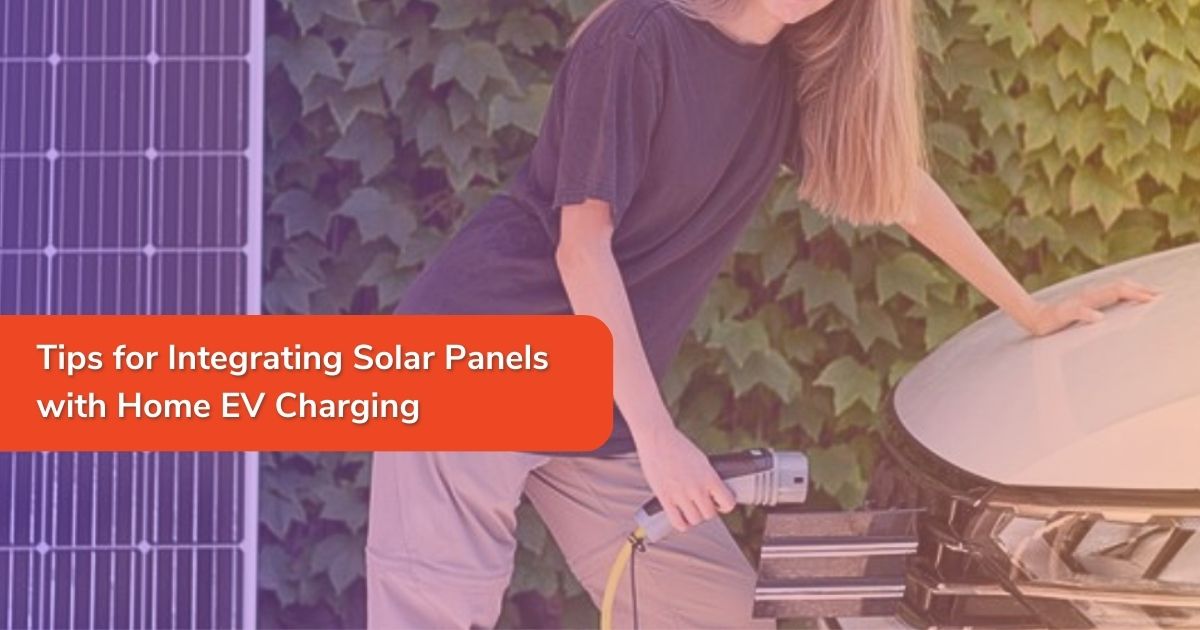Tips for Integrating Solar Panels with Home EV Charging

Australia boasts ample sunshine and is swiftly moving toward sustainable practices. As solar energy systems and electric vehicles (EVs) gain popularity, the natural next step for forward-thinking Australians is to integrate the two, reducing the carbon footprint of travel and home energy consumption. This trend is indicative of a broader shift toward sustainable living practices, reflecting a growing concern for the environment and a desire for greater energy independence. Here's a guide for all Australians seeking to marry their home's solar power with the growing trend of electric cars, to not only enhance sustainability but also enjoy financial and environmental benefits. In this article, we’ll provide insights and tips for making the most of this integrated approach.
Benefits of Integrating Solar Panels with Home EV Charging
Reduced Electricity Costs
Integrating solar panels with home EV charging can significantly reduce electricity bills. By producing your own energy from the sun during peak charging times, you effectively cut or eliminate costs associated with traditional grid power. This is especially beneficial if your EV charging demands align with daylight hours when solar generation is at its highest.
Environmental Sustainability
The environmental benefits of solar energy and EVs are well-established. Solar power is a clean, renewable energy source that minimises greenhouse gas emissions. When used to charge EVs, the reduction in tailpipe emissions further contributes to a healthier environment. This integrated system serves as a tangible way for individuals to combat climate change and lower their ecological impact.
Increased Energy Independence
By generating and storing your own electricity, you reduce reliance on the traditional energy grid. This added level of energy independence is not only beneficial during power outages but also provides a sense of security and control over your home energy needs.
Considerations for Integration
Assessing Energy Needs and Requirements
Start by evaluating your household's energy requirements and the potential demand that an electric vehicle would add. A professional energy assessment can provide insights into your specific situation, helping you to understand the size and type of solar PV system needed.
Evaluating Solar Panel Capacity
The capacity of your solar panels should be sufficient to cover both household energy consumption and the additional load of EV charging. It’s advised to consider a slight overcapacity to account for future energy needs and system degradation over time.
Selecting the Right EV Charging Equipment
It’s crucial to choose an EV charging solution that is compatible with your solar PV system and meets both your current and future charging needs. This includes considering the charging speed, portability, and any additional features like smart or off-grid capabilities.
Installation Process
Finding Qualified Installers
Work with accredited solar and electric vehicle charging system installers to ensure professional and safe integration. Companies with experience in both solar and EV technologies are well-placed to provide effective solutions.
Obtaining Necessary Permits and Approvals
The installation of solar panels and EV charging equipment may require permits from local councils or energy authorities. Ensure that all necessary approvals are obtained before the installation process begins.
Ensuring Proper Electrical Connections
Electricity generated by solar panels and used for EV charging will need to be safely connected to your home's electrical system. This may necessitate upgrades to your existing wiring or the addition of new circuits, tasks best left to the professionals.
Optimising Efficiency
Time-of-Use Charging
Leverage time-of-use (TOU) tariffs for EV charging, if available in your area. These tariffs align with solar generation peaks, enabling you to charge your EV when electricity is cheapest or when excess solar energy is being produced.
Maximising Solar Generation and Consumption
Use power-diverter systems or smart home energy solutions to direct excess solar energy toward EV charging or other household appliances. This maximises the use of self-generated power and further reduces grid reliance.
Monitoring and Managing Energy Usage
Invest in a home energy management system that can track and optimise your energy usage, ensuring that solar generation is efficiently utilised and that EV charging does not interfere with other priority loads.
Financial Incentives and Rebates
Government Incentives for Solar and EVs in Australia
Australia offers various federal and state-level incentives to support the adoption of both solar energy and electric vehicles. These can include grants, tax credits, and low-interest loans.
Available Rebates and Subsidies
Research the rebates and subsidies that may be available for the purchase and installation of solar PV systems and EV charging infrastructure. These incentives can make the upfront costs more manageable and provide a significant return on investment.
Potential Challenges and Solutions
Grid Connection Limitations
In some regions, there may be restrictions on the amount of energy that one can feed back into the grid. Potential solutions include using more of your solar energy on-site or exploring options for energy storage through home batteries.
Battery Storage Options
Home battery storage, such as a solar battery or EV battery, can store energy for later use, particularly during peak charging times when solar generation is minimal. Investigate the benefits of battery solutions and their compatibility with your integrated solar and EV system.
Managing Peak Demand
Peak energy demand, particularly during peak solar production and EV charging, can strain the system. To mitigate this, consider smart charging solutions that can adjust charging rates based on energy availability and usage patterns.
Conclusion
The integration of solar panels with home EV charging in Australia is an exciting frontier, offering the promise of sustainable and economical energy practices. By carefully considering system capacity, selecting the right equipment, optimising usage, and leveraging available incentives, you can create a harmonious system that benefits both your wallet and the environment. As you embark on this energy journey, remember that every kilowatt-hour saved and every bit of cleaner air matters. The sun is shining, and your EV is waiting to be charged with sustainable power – are you ready to make the switch? Contact us today at Smart Energy Answers.
%20(1).png?width=265&height=96&name=www.smartenergyanswers.com.auhs-fshubfsSmart%20Energy%20Answers%20Logo%20(HIRES)%20(1).png)

.png?width=514&height=121&name=Tesla%20Powerwall%203%20(new).png)







